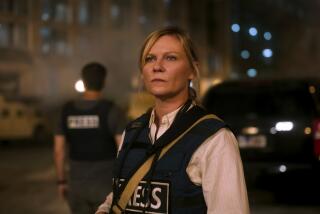On the Same Wavelength
- Share via
“The past is a funny thing,” John Sullivan (Jim Caviezel) says in “Frequency,” an effective but finally overreaching science-fiction thriller, but even he doesn’t yet appreciate just how out of the ordinary it can be.
Cleverly written by Toby Emmerich and tightly directed by the very capable Gregory Hoblit, “Frequency” takes a standard sci-fi stratagem and runs with it. No, its plot doesn’t make conventional sense, but we are happy to buy into it--at least up to a point. We empower films like this because we want to, because filmmaking skill encourages us to suspend disbelief and agree, even if only for awhile, that seeing really is believing.
Links between the present, the future and the past, the ability to move people (or in this case, information) through time is a science-fiction staple with understandable appeal. Who wouldn’t want to go back and correct a past mistake or embark, with the wisdom of hindsight, on a path foolishly not taken?
There is, of course, a classic hitch to this perpetual daydream. Anything you redo in the past by definition affects the future (that’s in fact the plot hook of both “Terminator” epics), and often in ways that are impossible to foresee. It’s a domino effect with potentially catastrophic implications, a poison pill that lies at the heart of this film’s complicated structure.
“Frequency” opens with something very concrete and specific: a graphic tanker truck accident on an offramp of New York’s George Washington Bridge. This bravura sequence not only sets up Frank Sullivan (Dennis Quaid) as the kind of casually heroic fireman who thinks risking his life is no big deal, it establishes the action bona fides of director Hoblit.
Working with cinematographer Alar Kivilo and editor David Rosenbloom, Hoblit knows how to ratchet up the tension and isn’t afraid to do so, giving us reason to be patient through the extensive exposition that follows before the excitement starts up again.
Though it looks contemporary, that rescue scene takes place on Oct. 10, 1969. Sullivan, married to the appealing Julia (Elizabeth Mitchell) and with a 6-year-old son named Johnny, lives in Bayside, Queens, and is by all appearances the happiest family man in all five boroughs.
In whatever time he can spare from teaching Johnny to ride a bike, Sullivan is a ham radio operator, and that night turns out to be a special one. Aurora borealis, the northern lights, are visible over Queens and doing strange things to the atmosphere. “I’m picking up frequencies,” Sullivan says, “from places I could never reach.” No kidding.
Just like that, it’s 30 years later, Oct. 10, 1999, the northern lights have returned, and little Johnny is grown up into darkly handsome John, a New York City police detective. Conveniently enough he still lives in the Bayside house he grew up in though his father is now dead and his mother moved to an apartment.
Rummaging through a closet, John comes across his dad’s old shortwave set and, on a whim, sets it up again while a TV talk-show voice in the background philosophizes about “time being far more fluid than anyone could have imagined.” A voice crackles through the static that sounds awfully familiar. Could it be his father, speaking to him from that same night 30 years ago? Though it astounds both men when they realize what’s happening, that’s exactly the case.
Suddenly, John realizes what the date is. On Oct. 11, 1969, his father died a hero’s death in a warehouse fire. Desperately, heedlessly, he gives his father some hurried advice over the radio that he hopes will save his life.
Apparently not a sci-fi fan, John doesn’t realize that attempting to make changes in the past will have powerful and unforeseen consequences in the present, but the rest of “Frequency” will teach him that lesson in a big way. In fact, John starts to feel he’s living in two realities at once, the one he remembers and the new one his actions have somehow created.
This is, as noted, not the most realistic of scenarios but it’s the gift of “Frequency” to make us feel it’s plausible. Strong acting is a key, especially by Caviezel, memorable as the AWOL soldier in “The Thin Red Line,” and by Andre Braugher as the policeman friend of two generations of Sullivans.
Also critical is Hoblit’s ability to add a level of realism to the proceedings. As he demonstrated in his two previous features, “Primal Fear” and “Fallen,” Hoblit has the kind of driving, involving style that is capable of creating credibility for far-fetched situations. In a scenario where reality can change in an instant, that’s a formidable talent to have.
Unfortunately, “Frequency,” after keeping its balance over much treacherous terrain, greedily overreaches and stumbles badly at the close. Screenwriter Emmerich (brother of actor Noah Emmerich, who plays John Sullivan’s pal Gordo Hersch) ends up trying for one twist too many and causing the whole delicately balanced house of cards to collapse. If only he could go back to the past and rewrite that part of the script, we’d all be grateful.
* MPAA rating: PG-13, for intense violence and disturbing images. Times guidelines: Firefighting images are especially intense.
‘Frequency’
Dennis Quaid: Frank Sullivan
Jim Caviezel: John Sullivan
Andre Braugher: Satch DeLeon
Elizabeth Mitchell: Julia Sullivan
Noah Emmerich: Gordo Hersch
Shawn Doyle: Jack Shepard
Released by New Line Cinema. Director Gregory Hoblit. Producers Hawk Koch, Gregory Hoblit, Bill Carraro, Toby Emmerich. Executive producers Robert Shaye, Richard Saperstein. Screenplay Toby Emmerich. Cinematographer Alar Kivilo. Editor David Rosenbloom. Costumes Elisabetta Beraldo. Music Michael Kamen. Production design Paul Eads. Art director Dennis Davenport. Set decorator Gordon Sim. Running time: 1 hour, 57 minutes.
In general release.
More to Read
Only good movies
Get the Indie Focus newsletter, Mark Olsen's weekly guide to the world of cinema.
You may occasionally receive promotional content from the Los Angeles Times.











